Ditapis dengan
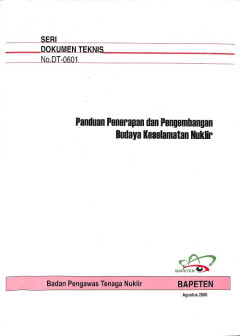
Seri Dokumen Teknis No. DT-0601 Panduan Penerapan dan Pengembangan Budaya Kes…
Pedoman ini merupakan petunjuk bagi pihak pengguna dan pengawas tenaga nuklir untuk menerapkan dan mengembangkan konsep budaya keselamatan nuklir serta untuk meningkatkan kesadaran berbagai pihak terkait terhadap budaya keselamatan nuklir. Pedoman ini juga sebagai modul sosialisasi maupun modul pelatihan budaya keselamatan nuklir.
- Edisi
- -
- ISBN/ISSN
- -
- Deskripsi Fisik
- 89 p. : illus. ; 29 cm
- Judul Seri
- Seri Dokumen Teknis No. DT-0601
- No. Panggil
- 621.48 BAP S
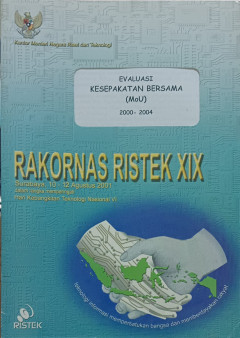
Evaluasi Kesepakatan Bersama (MOU) 2000-2004
Berisi jumlah kesepakatan bersama (MoU) yang ditandatangani oleh Menristek RI selama tahun 2000 sebanyak 15 kali; MoU yang ditandatangani Deputi Mneristek RI sebanyak 4 kali; dan MoU yang ditandatangani Asisten Deputi Menristek RI sebanyak 1 kali. Untuk Tahun 2001 MoU yang ditandatangani Menristek RI sebanyak 6 kali; MoU yang ditandatangani Asisten Menristek RI dan Asisten Deputi Menristek RI m…
- Edisi
- -
- ISBN/ISSN
- -
- Deskripsi Fisik
- 5 p. : Illus. ; 29 cm
- Judul Seri
- Rakornas Ristek XIX, Surabaya, 10-12 Agustus 2001
- No. Panggil
- 607.2598 BAT r (2)
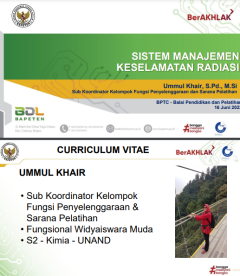
Sistem Manajemen Keselamatan Radiasi (PPT)
PPT berisi prinsip sistem manajemen secara umum, sistem dokumentasi dan SOP yang digunakan, pengendalian peralatan, dan pengendalian proses, pengendalian pekerja radiasi dan kompetensi. Selain itu, tentang pekerja dalam hal proteksi radiasi, pengendalian ketidaksesuaian, tindakan korektif dan pencegahan. Daftar Isi: Pendahuluan : aspek legal & latar belakang Konsep SM : pengertian SM, ele…
- Edisi
- -
- ISBN/ISSN
- -
- Deskripsi Fisik
- 43p. : illus. ; pdf
- Judul Seri
- -
- No. Panggil
- 628.535 KHA S

Buku III: Himpunan Rencana Kerja dan Anggaran Kementerian Negara/Lembaga (RKA…
Berdasarkan Pasal 15 Undang-Undang Nomor 17 Tahun 2003 Tentang Keuangan Negara diatur bahwa dalam rangka penyusunan RAPBN, Menteri/Pimpinan Lembaga selaku Pengguna Anggaran / Pengguna Barang menyusun Rencana Kerja Anggaran Kementerian/Lembaga (RKA-K/L) tahun berikutnya. RKA-K/L tersebut disusun berdasarkan prestasi kerja yang akan dicapai, dan disertai dengan prakiraan belanja untuk tahun berik…
- Edisi
- -
- ISBN/ISSN
- -
- Deskripsi Fisik
- - p. : Illus. ; 29 cm
- Judul Seri
- -
- No. Panggil
- 658.401 REP H
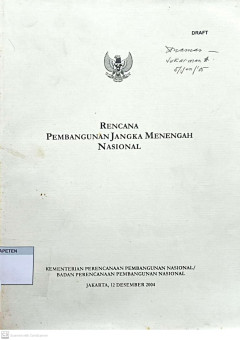
Draft Rencana Pembangunan Jangka Menengah Nasional
Berisi draft rencana pembangunan jangka menengah nasional meliputi : Bagian I: Permasalahan dan Agenda Pembangunan Nasional; Bagian II: Agenda Menciptakan Indonesia yng Aman dan Damai; Bagian III: Agenda Menciptakan Indonesia yang Adil dan Demokratis; Bagian IV: Agenda Meningkatkan Kesejahteraan Rakyat; Bagian V: Kerangka Ekonomi Makro dan Pembiayaan; dan Bagian VI: Penutup. (Jml)
- Edisi
- -
- ISBN/ISSN
- -
- Deskripsi Fisik
- - p. : Illus. 30 cm
- Judul Seri
- -
- No. Panggil
- 658.401 KEM R
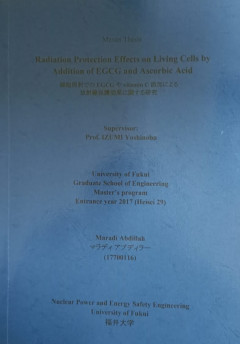
Radiation Protection Effects on Living Cells by Addition of EGCG and Ascorbic…
Radiation is different from many other things that we cone into contact in our daily lives, because we can't see it, we can't feel, we can't smell it, we can't hear it, and we can't taste it. Thus, we will know if our body are now being exposed to radiation unless we measure it using radiaiton monitoring devices. In fact, we have been exposed to natural radiation in everyday life since the time…
- Edisi
- -
- ISBN/ISSN
- -
- Deskripsi Fisik
- 73p;illus, 29cm
- Judul Seri
- -
- No. Panggil
- 614.839 ABD R
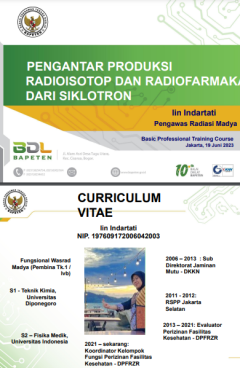
Pengantar Produksi Radioisotop dan Radiofarmaka Siklotron (PPT)
PPT ini berisi tentang definisi produksi radioisotop dan radiofarmaka, sistem keselamatan dan desain fasilitas produksi radioisotop dan radiofarmaka. Selain itu, tentang potensi bahaya radiasi pada fasilitas produksi radioisotop dan radiofarmaka, penanganan keadaan darurat & dekontaminasi. Pokok pembahasan lain menjelaskan tentang pengelolaan limbah radioaktif. PPT dipresentasikan dalam acar…
- Edisi
- -
- ISBN/ISSN
- -
- Deskripsi Fisik
- 52p. : Illus. pdf
- Judul Seri
- -
- No. Panggil
- 604 IND P
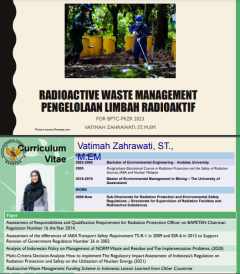
Pengelolaan Limbah Radioaktif (PPT)
Sumber radioaktif yang sebelumnya bekas digunakan untuk medik, namun karena kurangnya kepedulian terhadap bahaya radiasi, masyarakat lokal mengambil sumber tersebut dari fasilitas medik yang sudah ditinggalkan. Sumber radioaktif tersebut dibuka dan isi radioaktif tersebar ke area yang cukup luas. Daftar isi PPT: Introduction Regulations in Indonesia Radioactive waste classification Peng…
- Edisi
- -
- ISBN/ISSN
- -
- Deskripsi Fisik
- 54 p. : Illus, pdf
- Judul Seri
- -
- No. Panggil
- 604 ZAh P

Program Start Up Capital: Permodalan Awal untuk Industri Kecil Menengah berba…
Buku ini berisikan Program Start Up Capital Permodalan Awal Untuk IKMT Melalui Modal Ventura yang disusun oleh Kementerian Riset Dan Teknologi pada Januari 2003
- Edisi
- -
- ISBN/ISSN
- -
- Deskripsi Fisik
- 25 p. : Illus. ; 21 cm
- Judul Seri
- -
- No. Panggil
- 658.02 KEM P
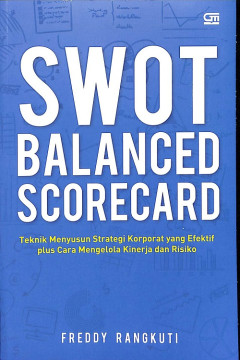
SWOT Balanced Scorecard: Teknik Menyusun Strategi Korporat yang Efektif plus …
Buku ini akan membimbing kita untuk langsung praktik menerjemahkan visi, misi, strategi dan program ke dalam seperangkat ukuran yang tepat. Semua ukuran tersebut disusun secara komprehensif dan terintegrasi dengan tujuan strategis, sasaran strategis, target, key performance Indicators, cara mencapai target ke dalam sistem manajemen. Selanjutnya sistem ini akan mengkomunikasikan kepada seluruh k…
- Edisi
- -
- ISBN/ISSN
- 9786020307121
- Deskripsi Fisik
- 283 p. : illis. ; 23 cm
- Judul Seri
- -
- No. Panggil
- 658 RAN s
 Karya Umum
Karya Umum 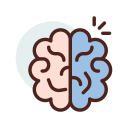 Filsafat
Filsafat  Agama
Agama 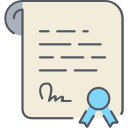 Ilmu-ilmu Sosial
Ilmu-ilmu Sosial  Bahasa
Bahasa  Ilmu-ilmu Murni
Ilmu-ilmu Murni 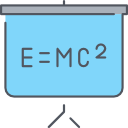 Ilmu-ilmu Terapan
Ilmu-ilmu Terapan  Kesenian, Hiburan, dan Olahraga
Kesenian, Hiburan, dan Olahraga  Kesusastraan
Kesusastraan  Geografi dan Sejarah
Geografi dan Sejarah